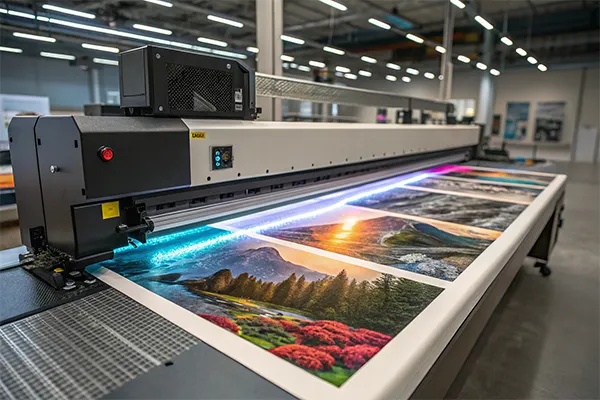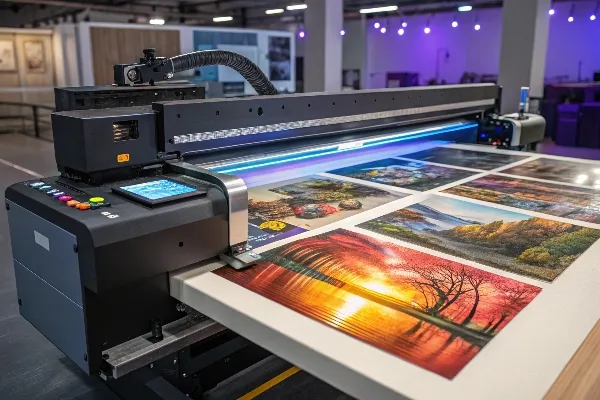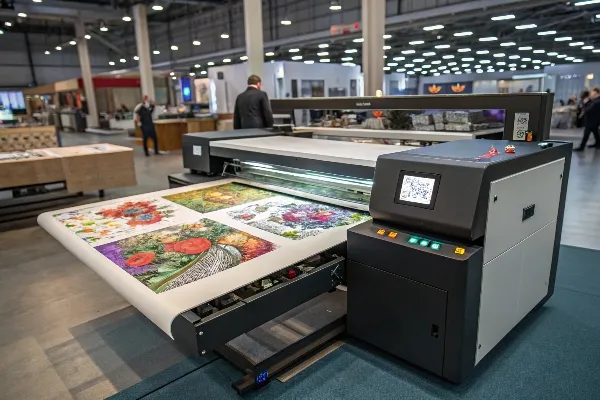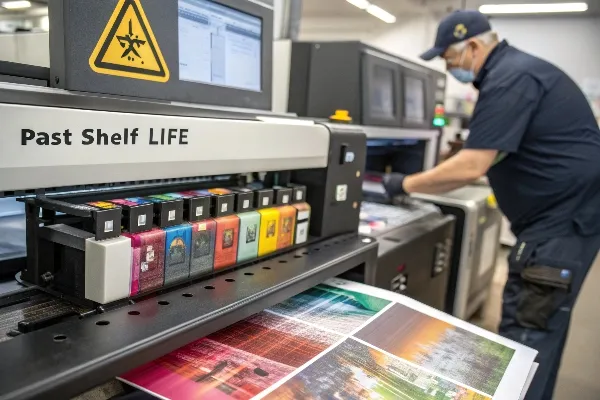لتجنب تأخير الرد على استفسارك، يرجى إدخال رقم WhatsApp/WeChat/Skype الخاص بك مع الرسالة، حتى نتمكن من الاتصال بك في المرة الأولى
سوف نقوم بالرد عليك خلال 24 ساعة. إذا كانت الحالة عاجلة، يرجى إضافة WhatsApp: +86 17864107808أو WeChat: +86 17864107808. أو اتصل +86 17864107808 مباشرة.
*نحن نحترم خصوصيتك وجميع المعلومات محمية. لن نستخدم معلوماتك إلا للرد على استفساراتك ولن نرسل لك رسائل بريد إلكتروني أو رسائل ترويجية غير مرغوب فيها.
هل أنت مهتم بالطابعات المسطحة بالأشعة فوق البنفسجية؟ هذه الطابعات هي من أحدث التقنيات في الصناعات التي تبحث عن التنوع والجودة في الطباعة. ولكن ما الذي يجعلها مميزة على وجه التحديد؟
تستخدم الطابعات المسطحة بالأشعة فوق البنفسجية الضوء فوق البنفسجي لتجفيف الحبر، مما يسمح لها بالطباعة على مواد مختلفة بمتانة مذهلة. وهي مثالية للشركات التي تتطلب الجودة والتنوع في عمليات الطباعة الخاصة بها.

طابعة مسطحة بالأشعة فوق البنفسجية
رغم أن الطابعات المسطحة بالأشعة فوق البنفسجية تقدم فوائد مذهلة، إلا أنها تأتي مع بعض الجوانب السلبية. دعونا نتعمق في بعض التحديات المرتبطة بهذه الآلات.
على الرغم من قدراتها المذهلة، فإن الطابعات فوق البنفسجية تواجه مجموعة من التحديات الخاصة بها. إذا كنت تفكر في شراء واحدة، فمن الضروري معرفة العيوب المحتملة.
قد يكون شراء الطابعات فوق البنفسجية وصيانتها مكلفًا. فهي تتطلب عناية متخصصة، وقد تكون الأحبار باهظة الثمن. بالإضافة إلى ذلك، ليست كل المواد مثالية للطباعة فوق البنفسجية دون تحضير إضافي.

تحدي الطابعة فوق البنفسجية
يمكن أن تشكل التكلفة الأولية المرتفعة لطابعات الأشعة فوق البنفسجية عائقًا كبيرًا للشركات الصغيرة أو الشركات الناشئة. وفي حين أن تنوع هذه الطابعات لا مثيل له، فإن التكلفة الأولية ونفقات الصيانة يمكن أن تتراكم بسرعة. بالإضافة إلى الطابعة نفسها، تحتاج طابعات الأشعة فوق البنفسجية إلى أحبار متخصصة يمكن أن تكون باهظة الثمن. كما أن هذه الأحبار لها عمر تخزين أقصر، مما يؤدي إلى تكاليف إضافية في إدارة المخزون.
من التحديات الأخرى التي تواجه الطابعات فوق البنفسجية حساسيتها للظروف البيئية. تتطلب هذه الآلات بيئات تشغيل محددة للعمل بشكل صحيح. وقد لا تعمل بشكل جيد في درجات حرارة عالية أو منخفضة للغاية، أو في أماكن ذات مستويات رطوبة عالية. بالإضافة إلى ذلك، يحتاج حبر الأشعة فوق البنفسجية إلى تهوية مناسبة، حيث يمكن أن ينبعث منه أبخرة أثناء عملية الطباعة. وبدون الإعداد الصحيح، قد لا تعمل الطابعة بشكل جيد أو تتطلب إصلاحات متكررة.
تتطلب الطابعات فوق البنفسجية أيضًا صيانة منتظمة للحفاظ على سير كل شيء بسلاسة. يجب استبدال مصابيح المعالجة، على وجه الخصوص، بعد عدد معين من الساعات للحفاظ على جودة الطباعة. قد تحتاج رؤوس الطباعة أيضًا إلى التنظيف بانتظام لتجنب انسداد الحبر، مما قد يؤثر على الناتج الإجمالي للطباعة. يضيف هذا وقتًا وجهدًا إضافيين لصيانة الطابعة.
تشتهر الطابعات فوق البنفسجية بقدرتها على الطباعة على مجموعة واسعة من المواد. ولكن هل يمكنها حقًا الطباعة على أي شيء؟ دعنا نستكشف ذلك.
تتميز الطابعات فوق البنفسجية بتعدد استخداماتها ويمكنها الطباعة على العديد من الأسطح، بما في ذلك الخشب والزجاج والمعادن والبلاستيك وغيرها. ومع ذلك، قد تتطلب بعض المواد تحضيرات أو إعدادات خاصة للحصول على نتائج مثالية.

طابعة الأشعة فوق البنفسجية للطباعة على مواد متعددة
تشتهر الطابعات فوق البنفسجية بقدرتها على الطباعة على أي مادة مسطحة تقريبًا، من الورق إلى المعدن والزجاج. وهذا يجعلها مثالية للصناعات التي تحتاج إلى مطبوعات عالية الجودة على أسطح فريدة. على سبيل المثال، يمكنك الطباعة على الخشب لإنشاء قطع أثاث مخصصة، أو على الزجاج للعناصر الترويجية واللافتات. تتيح تعدد استخدامات الطابعات فوق البنفسجية للشركات تقديم مجموعة واسعة من المنتجات، من العبوات المخصصة إلى الهدايا الشخصية.
ومع ذلك، في حين أن الطابعات فوق البنفسجية يمكنها التعامل مع مجموعة متنوعة من المواد، فإن بعضها يتطلب معالجة مسبقة. قد تحتاج بعض المواد البلاستيكية أو المعدنية إلى التحضير قبل الطباعة لضمان التصاق الحبر بشكل صحيح. في بعض الحالات، قد تحتاج إلى ضبط الإعدادات للمادة التي تطبع عليها. على سبيل المثال، قد تتطلب الطباعة على القماش أنواعًا معينة من الحبر أو تعديلات لتجنب التلطيخ أو التغطية غير المتساوية. وعلى الرغم من هذه التعديلات البسيطة، تظل قدرة الطباعة فوق البنفسجية على الطباعة على كل سطح تقريبًا نقطة بيع مهمة.
من المهم ملاحظة أن بعض الأسطح قد لا تكون مناسبة للطباعة بالأشعة فوق البنفسجية، وخاصة إذا كانت مسامية أو ذات ملمس خشن. وفي حين تعمل الطباعة بالأشعة فوق البنفسجية بشكل جيد على الأسطح الملساء غير المسامية، فإن الطباعة على مواد ذات ملمس خشن قد تؤدي إلى تغطية غير متساوية أو تجمع الحبر. لذلك، من الضروري اختبار مواد وإعدادات مختلفة لضمان أفضل النتائج الممكنة.
الطابعات فوق البنفسجية هي استثمار طويل الأجل، ولكن إلى متى يمكن أن تدوم فعليًا؟ دعونا نلقي نظرة على عمرها الافتراضي.
مع الصيانة المناسبة، طابعة الأشعة فوق البنفسجية1 يمكن أن تدوم من 5 إلى 10 سنوات. يمكن أن يؤدي الصيانة والعناية المنتظمة إلى إطالة عمرها والحفاظ على أدائها في أفضل حالاته.

عمر طابعة الأشعة فوق البنفسجية وصيانتها
يمكن أن تدوم طابعة الأشعة فوق البنفسجية من 5 إلى 10 سنوات، اعتمادًا على مدى صيانتها. تمامًا مثل أي قطعة من المعدات، فإن طول عمر طابعة الأشعة فوق البنفسجية الخاصة بك مرتبط ارتباطًا وثيقًا بمدى العناية التي تتلقاها. التنظيف المنتظم والتعامل السليم مع رؤوس الطباعة والصيانة الروتينية سيقطع شوطًا طويلاً في إطالة عمر الطابعة. استبدال أجزاء مثل رؤوس الطباعة2 أو يمكن أن يساعد تشغيل مصابيح المعالجة على فترات زمنية موصى بها في الحفاظ على عمل الطابعة بسلاسة.
يعد رأس الطباعة أحد أهم المكونات في طابعة الأشعة فوق البنفسجية، وهو المسؤول عن ترسيب الحبر على المادة. بمرور الوقت، يمكن أن تتآكل هذه الرؤوس، خاصة مع الطباعة بكميات كبيرة. إذا تم استخدام الطابعة بشكل متكرر أو لتشغيلات كبيرة، فمن الضروري التحقق من حالة رؤوس الطباعة بانتظام واستبدالها حسب الحاجة. قد يؤدي إهمال القيام بذلك إلى انسداد رؤوس الطباعة أو تلفها، مما يؤثر على جودة الطباعة ويتطلب إصلاحات باهظة الثمن.
تتمتع مصابيح المعالجة أيضًا بعمر افتراضي محدود، وعادة ما يتراوح بين 1000 إلى 1500 ساعة من الاستخدام. وبعد هذه الفترة، تبدأ المصابيح في فقدان فعاليتها، مما قد يؤدي إلى ضعف معالجة الحبر وتلاشي المطبوعات. ولضمان الأداء الأمثل، من الضروري استبدال مصابيح المعالجة في الوقت المناسب. باتباع ممارسات الصيانة هذه، يمكنك زيادة عمر طابعة الأشعة فوق البنفسجية الخاصة بك إلى أقصى حد والحصول على أقصى قيمة من استثمارك.
هل تفكر في شراء طابعة UV؟ دعنا نناقش سبب كونها خيارًا شائعًا للعديد من الشركات والصناعات.
توفر الطابعات فوق البنفسجية تنوعًا وجودة لا مثيل لها، مما يجعلها خيارًا ممتازًا للشركات التي تحتاج إلى الطباعة على مجموعة متنوعة من المواد وإنتاج مطبوعات عالية الجودة ومتينة.

عنوان
هناك عدة أسباب تجعل الشركات تستثمر في طابعات الأشعة فوق البنفسجية. من أهم المزايا التي تتمتع بها الطابعات فوق البنفسجية هي تعدد استخداماتها. حيث تستطيع الطابعات فوق البنفسجية الطباعة على أي مادة مسطحة تقريبًا، مما يفتح مجموعة واسعة من الاحتمالات للمنتجات المخصصة والتغليف والعناصر الترويجية. سواء كنت تطبع على الخشب أو البلاستيك أو الزجاج أو المعدن، فإن الطابعة فوق البنفسجية قادرة على التعامل مع كل ذلك. تتيح هذه المرونة للشركات تلبية احتياجات مجموعة واسعة من الصناعات، من اللافتات والإعلانات إلى الهدايا والتغليف المخصصة.
فائدة رئيسية أخرى لـ طابعات الأشعة فوق البنفسجية تتمثل جودة الطباعة في عملية المعالجة بالأشعة فوق البنفسجية التي تعمل على تصلب الحبر على الفور، مما ينتج عنه مطبوعات نابضة بالحياة ومتينة ومقاومة للبهتان والخدوش والتلف الناتج عن الماء. وهذا يجعل المطبوعات بالأشعة فوق البنفسجية مثالية للتطبيقات الداخلية والخارجية، وخاصة للمنتجات التي تحتاج إلى مقاومة التآكل والتلف. تتمتع المطبوعات بالأشعة فوق البنفسجية أيضًا بمقاومة أعلى للأشعة فوق البنفسجية، مما يضمن عدم بهتانها بسرعة مثل المطبوعات من الطابعات التقليدية.
علاوة على ذلك، تعد الطابعات فوق البنفسجية صديقة للبيئة. فالأحبار المستخدمة في الطباعة فوق البنفسجية خالية من المركبات العضوية المتطايرة (VOCs)، مما يجعلها خيارًا أكثر أمانًا للبيئة والعمال الذين يتعاملون مع المطبوعات. ونظرًا لأن الحبر يجف على الفور، فلا توجد حاجة لوقت تجفيف، مما يساعد أيضًا في تقليل استهلاك الطاقة. بالنسبة للشركات التي تركز على الاستدامة، توفر الطباعة فوق البنفسجية بديلاً أكثر خضرة لطرق الطباعة التقليدية.
تمامًا مثل أي حبر، فإن حبر الأشعة فوق البنفسجية له مدة صلاحية. ولكن ماذا يحدث عندما تنتهي صلاحيته؟ دعنا نستكشف العواقب.
عندما تنتهي صلاحية حبر الأشعة فوق البنفسجية، يمكن أن يؤدي ذلك إلى رؤوس الطباعة مسدودة1، طباعة غير متناسقة، وضعف الالتصاق. من المهم مراقبة العمر الافتراضي لحبر الأشعة فوق البنفسجية لتجنب هذه المشكلات.

تأثير انتهاء صلاحية حبر الأشعة فوق البنفسجية
قد يتسبب حبر الأشعة فوق البنفسجية منتهي الصلاحية في حدوث العديد من المشكلات التي تؤثر على جودة المطبوعات. والمشكلة الأكثر شيوعًا هي الانسداد. فمع مرور الوقت، قد يتكاثف الحبر ويتصلب، مما يجعل من الصعب تدفقه عبر رؤوس الطباعة. وقد يؤدي هذا إلى طباعة غير متسقة، أو صور رديئة الجودة، أو حتى أعطال الطابعة. وقد يفقد الحبر منتهي الصلاحية أيضًا قدرته على التصلب بشكل صحيح تحت ضوء الأشعة فوق البنفسجية، مما قد يؤدي إلى تلطيخ أو عدم اكتمال المطبوعات.
تتمثل مشكلة أخرى في الحبر منتهي الصلاحية في أنه قد لا يلتصق بشكل صحيح بالمادة، مما يؤدي إلى تقشير المطبوعات أو بهتانها بسهولة. وهذا يمثل مشكلة خاصة بالنسبة للمنتجات التي تتطلب مطبوعات تدوم طويلاً، مثل اللافتات الخارجية أو العبوات المخصصة. لمنع هذه المشكلات، من الضروري التحقق من تواريخ انتهاء صلاحية أحبار الأشعة فوق البنفسجية بانتظام واستبدال أي حبر منتهي الصلاحية قبل الاستخدام.
بالإضافة إلى ذلك، يمكن للحبر منتهي الصلاحية أن يتلف مكونات الطابعة. إذا أصبح الحبر سميكًا جدًا أو متكتلًا، فقد يتسبب ذلك في انسداد نظام توصيل الحبر، مما يؤدي إلى إصلاحات مكلفة. يمكن أن يساعد تخزين الحبر بشكل صحيح - بعيدًا عن الضوء والحرارة - في إطالة عمره الافتراضي وضمان بقائه صالحًا للاستخدام لأطول فترة ممكنة.
إذا كنت تتساءل عما إذا كانت المطبوعات فوق البنفسجية مقاومة للماء، فأنت لست وحدك. دعنا نكتشف مدى مقاومة المطبوعات فوق البنفسجية للماء حقًا.
نعم، عادةً ما تكون المطبوعات بالأشعة فوق البنفسجية مقاومة للماء بمجرد معالجتها بالكامل. يتصلب الحبر تحت ضوء الأشعة فوق البنفسجية، مما يجعله مقاومًا للماء والعوامل البيئية الأخرى.
المطبوعات فوق البنفسجية تشتهر هذه المواد بمتانتها، وبمجرد أن يجف الحبر تمامًا، يصبح مقاومًا للماء. تعمل عملية المعالجة بالأشعة فوق البنفسجية على تقوية الحبر، مما يخلق طبقة واقية يمكنها تحمل التعرض للماء والخدوش والبهتان. وهذا يجعل الطباعة بالأشعة فوق البنفسجية خيارًا ممتازًا للمنتجات والمواد التي ستتعرض للعوامل الجوية، مثل اللافتات الخارجية والتغليف والعناصر الترويجية.
ومع ذلك، في حين أن المطبوعات بالأشعة فوق البنفسجية مقاومة للماء، فإن مستوى المقاومة قد يختلف حسب المادة والظروف التي تتعرض لها الطباعة. على سبيل المثال، تكون المطبوعات على مواد غير مسامية مثل الأكريليك أو الزجاج أكثر مقاومة للماء بشكل عام من تلك الموجودة على الأسطح المسامية مثل القماش أو الخشب. في بعض الحالات، يمكن أن يؤدي وضع طبقة واقية أو صفائح فوق الطباعة إلى تعزيز مقاومتها للماء بشكل أكبر، خاصة بالنسبة للمنتجات التي ستتعرض لظروف جوية قاسية.
من المهم ملاحظة أنه على الرغم من أن المطبوعات فوق البنفسجية مقاومة للماء، إلا أنها قد لا تكون مقاومة للماء تمامًا في جميع الظروف. بالنسبة للمنتجات التي ستغمرها المياه باستمرار أو تتعرض لرطوبة مفرطة، فقد تكون هناك حاجة إلى طلاءات أو معالجات إضافية لضمان المتانة على المدى الطويل.
تتميز الطابعات المسطحة بالأشعة فوق البنفسجية بتعدد استخداماتها بشكل لا يصدق وتنتج مطبوعات متينة، ولكنها تواجه بعض التحديات. وتعتبر الصيانة المناسبة وإدارة الحبر أمرًا أساسيًا لتحقيق أقصى استفادة من هذه الطابعات.